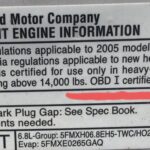Converting a 1993 Ford Bronco with a 351w engine and OBD1 system to OBD2 can seem daunting. This guide clarifies the process, focusing on the key components and wiring considerations for a successful conversion using a donor vehicle. This conversion is often necessary to utilize a newer engine, like the F4TE block with a roller cam, which requires an OBD2 system.
Key Differences Between OBD1 and OBD2 Systems
The primary difference lies in the complexity of the OBD2 system. OBD2 utilizes a more sophisticated computer system, evident in the “jungle of wires” under the dash of the donor vehicle. This includes the diagnostic link connector (DLC), often referred to as the OBD2 port, an additional computer module, and a more intricate instrument cluster wiring setup. These components contribute to OBD2’s enhanced diagnostic capabilities and emissions control.
Essential Components for the Conversion
To ensure the donor engine runs smoothly in your Bronco, you’ll need to salvage several key components from the OBD2 donor vehicle:
- Engine Control Unit (ECU): The OBD2 ECU, also known as the Powertrain Control Module (PCM), is crucial. It manages fuel injection, ignition timing, and emissions control.
- Wiring Harness: The complete engine wiring harness from the donor vehicle is essential for connecting the OBD2 ECU to the engine’s various sensors and actuators. This includes the fuel injector harness.
- Mass Air Flow (MAF) Sensor and Housing: The OBD2 system relies on a MAF sensor to measure the incoming air, crucial for accurate fuel delivery. Ensure you grab the entire housing assembly.
- Oxygen Sensors: OBD2 systems typically use multiple oxygen sensors (pre-catalytic converter and post-catalytic converter) for precise emissions monitoring.
- Diagnostic Link Connector (DLC): Install the OBD2 DLC from the donor vehicle to allow for code reading and diagnostics.
Wiring and Pinout Considerations
The conversion requires careful re-pinning of your Bronco’s existing wiring harness to accommodate the OBD2 system. Specifically, you’ll need to address:
- Automatic 4×4: The wiring for your Bronco’s automatic 4×4 system needs to be integrated into the OBD2 PCM. Consulting wiring diagrams for both vehicles is crucial for accurate pinout identification.
- Rear Power Windows: Similarly, the wiring for your Bronco’s rear power windows must be incorporated into the new PCM.
- Transmission: While both trucks have an E4OD transmission, the OBD2 system likely incorporates additional sensors. Verify compatibility and consider swapping the transmission if significant differences exist. Careful research is recommended.
Resources for Re-Pinning
Locating accurate wiring diagrams (pinouts) for both your 1993 Bronco and the 1995 F-150 donor vehicle is paramount for successful re-pinning. Online forums dedicated to Ford trucks (like FSB forums and F150 forums) can provide valuable resources and community support.
Conclusion
Converting a Ford Bronco from OBD1 to OBD2 involves careful planning and execution. Gathering the necessary components, understanding the wiring differences, and meticulously re-pinning the harness are key steps. Utilize online resources and community forums to access wiring diagrams and gain insights from others who have completed similar conversions. This conversion will allow you to utilize a newer engine and benefit from the OBD2 system’s enhanced diagnostics.

